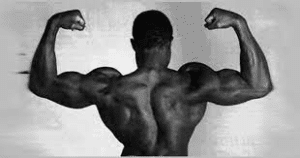Consider these variables that can result in asymmetries:
We have also seen athletes performing at the highest levels despite their imbalances.

Figure 1: Lamar Grant, a world record-holding powerlifter with idiopathic scoliosis

Figure 2: Jessica Ashwood, an Australian Olympic swimmer
Sustained postures during daily functioning:
Our bodies are incredibly adaptable. If you compare an office worker to a farmer or a sporting athlete, you’ll find that our bodies will adapt to the stressors that it is exposed to and they will distribute work among muscles to ensure we can move efficiently despite imbalances.
Unilateral Training:
Overemphasizing one side of the body during exercises or sports can result in imbalances between the right and left sides (i.e. Baseball, soccer or cricket players).
Injury or surgical history:
Muscular imbalances can develop due to past injuries or surgeries that affect specific muscle groups.
Common misconceptions of muscular imbalances while training
a) Doesn’t quadriceps dominance cause knee pain? If so, shouldn’t I aim to have my hamstring equally as strong as my quadriceps?
No, your quadriceps and hamstrings are distinct muscles with differing anatomical features, including origins, insertions, leverages, actions, and functions. From an anatomical perspective, it makes sense for the quadriceps to be stronger than the hamstrings due to their specific roles. We aim for specialization rather than equivalence; the quads should excel at their function, and the hamstrings should do the same. When we’re standing up from the bottom of a squat, we need our quadriceps and hamstrings to be good at working together so that we can create simultaneous hip and knee extension.
This doesn’t suggest a preference for weak hamstrings or overlooking their importance. The key here is understanding that having strong quadriceps isn’t inherently problematic, as long as we avoid loading at a pace that surpasses the knees’ ability to handle the stress.
b) Isn’t a hip shift in my squat going to hurt me?
While a hip shift might mean that one side is loaded more than the other, this imbalance isn’t inherently problematic. If your hip or knee is sensitive to loading, a shift to that side may cause discomfort, but the issue lies in the load tolerance. Whether the increased load comes from a shift or added weight on the bar, a hip/knee that is intolerant to loading will still be affected. It’s not as simple as deeming one side loaded more than the other as inherently bad. Lifting Injuries stem from a load management problem – whether a part is subjected to more stress than it can handle, regardless of the source of that load.
If you’ve consistently dealt with a shift, you’ve likely trained yourself to lift better within that pattern. Your hip shift prepares you to handle that specific movement. Evening things out abruptly could increase injury risk by exposing an unfamiliar pattern. While a hip shift may not be a significant concern in most cases, understanding what it indicates about your technique is crucial. Your body communicates your strengths, weaknesses, and effective ranges of motion through your technique.
Addressing a blatant deficiency isn’t going to prevent injuries; shifting suggests an uneven force application, and therefore, addressing this imbalance allows for an increased likelihood to increase overall force production. Focusing on a hip shift shouldn’t impede your training; work on it while still pushing your limits. If pain arises, recognize that the shift itself isn’t the problem; it’s a symptom. Identify the weaker components, address them, and become stronger.
When would asymmetry become a cause of concern?
Muscle imbalances may become a concern when they reach a point where they affect your overall well-being. Here are situations to take note of:
Presence of pain: If you experience persistent pain that is accompanied with muscle asymmetries after and if your pain that doesn’t improve with rest, it may indicate the need for attention.
Limitations to daily activities or general movement: Difficulty or restriction in certain movements may suggest that muscle imbalances are impacting your functional range of motion. If you find it challenging to perform everyday activities due to limited mobility, your imbalances could be contributing to these challenges.
Ultimately, humans are naturally asymmetrical, and embracing this asymmetry shouldn’t hinder your commitment to training or lead you to believe that imbalances are the sole cause of pain.
Key Points:
- 1. Having some degree of asymmetries & muscular imbalances is a normal part of being human, and it does not necessarily mean you should catastrophize them as a source of pain
- 2. Recognize that the muscle imbalances or asymmetries while lifting isn’t the problem; it’s a symptom. Identify the weaker components, address them, and become stronger
Not sure whether your imbalances are detrimental to your training and muscular health?
Book an appointment with one of our physios to address any concerns and questions you may have!
Phone: +65 8023 3805
Email: info@activexphysio.com
Book Online: activexphysio.com


